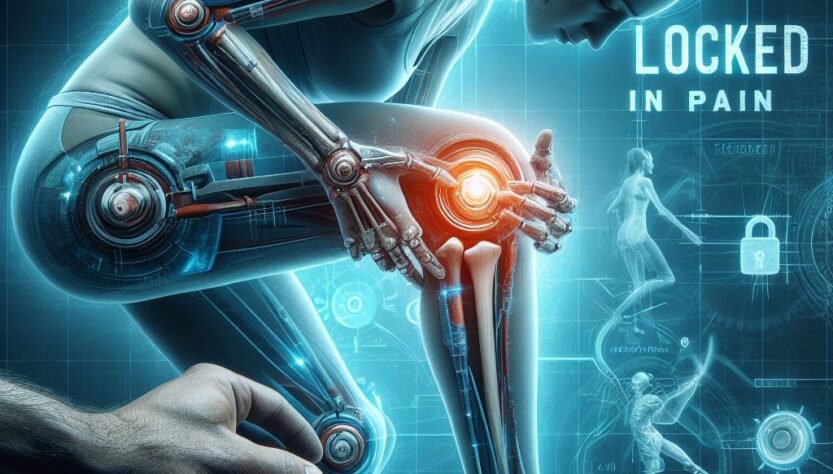Our knees are engineering marvels, bearing tremendous weight and enabling complex movements. But like any intricate machinery, they are susceptible to problems. One such issue is knee joint locking, which can leave you immobilized and frustrated. This article delves into the common causes of knee joint locking, helping you understand what might be behind the pain.
Causes of Knee Joint Locking:
Meniscus Tears
A meniscus tear is the leading cause of knee joint locking. The menisci are C-shaped pieces of cartilage that act as shock absorbers between the shinbone and thighbone. Sudden twisting or pivoting movements can tear these crucial structures, especially during sports. A torn meniscus fragment can wedge within the joint, causing a locking sensation. Additionally, degenerative changes associated with aging can increase the risk of meniscus tears.
Loose Bodies
Another culprit behind knee joint locking is the presence of loose bodies within the joint. These can be fragments of bone or cartilage that have broken off due to a prior injury, arthritis, or a stress fracture. As these loose bodies move around the joint, they can become lodged in a position that restricts movement and triggers a locking sensation.
Ligament Sprains
The ligaments of the knee provide stability and support. Sprains stretches, or tears of these ligaments can also contribute to knee joint locking. While less common than meniscus tears or loose bodies, ligament sprains, particularly those involving the posterior cruciate ligament (PCL), can cause the knee to catch or lock during specific movements.
Arthritis
Arthritis, a degenerative joint disease, is another potential cause of knee joint locking. Osteoarthritis, the most common form, involves the breakdown of cartilage within the knee joint. This breakdown leads to inflammation, bone spur formation, and restricted movement. These changes can sometimes cause the knee to lock, particularly when attempting to extend or bend the joint fully.
Plica Syndrome
Plica syndrome is a less well-known cause of knee joint locking. Plicae are standard folds in the synovial membrane, the lining of the knee joint. However, these folds can sometimes become inflamed or irritated, leading to pain, swelling, and a catching or locking sensation.
When to Seek Professional Help
If you experience knee joint locking, pain, swelling, instability, or difficulty walking, it’s crucial to seek professional help from a qualified healthcare provider like hipkneeortho. Early diagnosis and treatment can help prevent further damage and improve your long-term prognosis.
Treatment Options for Knee Joint Locking
The course of treatment for knee joint locking depends on the underlying cause identified by your doctor at hipkneeortho. Here’s a glimpse into some standard treatment approaches:
Rest and Rehabilitation: In many cases, especially for minor injuries like sprains or mild arthritis, the initial focus might be promoting healing through rest, ice therapy, compression, and elevation. Physical therapy plays a crucial role in strengthening the muscles that support the knee joint and improving flexibility, ultimately enhancing joint stability and reducing the risk of future locking episodes.
Medication: Medications can help manage pain and inflammation associated with knee joint locking. Over-the-counter pain relievers like ibuprofen or acetaminophen might be recommended. More potent drugs or injections may sometimes be needed for more severe pain or inflammation.
Arthroscopy: For certain conditions like meniscus tears or removal of loose bodies, minimally invasive arthroscopic surgery might be an option. This procedure involves inserting a tiny camera and surgical instruments through small incisions to diagnose and address the problem within the joint.
Bracing and Support: Depending on the cause of locking, your doctor might recommend wearing a knee brace to provide support and stability to the joint. This can help reduce pain and prevent further injury during activities.
Surgery: In severe cases, particularly for advanced arthritis or ligament injuries, surgery might be necessary to repair or reconstruct damaged structures within the knee joint. This is typically considered a last resort after exploring other conservative treatment options.
Importance of Early Intervention
Early diagnosis and treatment of knee joint locking are essential for faster recovery and preventing long-term complications. Ignoring the problem can worsen the underlying condition, leading to increased pain, stiffness, and potential joint damage. By seeking professional help from a qualified healthcare provider like hipkneeortho at the first sign of trouble, you can get on the path to regaining full function and mobility in your knee.
Conclusion
Knee joint locking can be a disruptive and painful experience. By understanding the common causes, you can be more aware of potential risks and seek timely medical attention. Consulting a healthcare professional like hipkneeortho is the first step towards regaining pain-free movement and enjoying an active life.
FAQs
Q: Can I treat knee joint locking at home?
A: While some home remedies, such as rest, ice, and compression, can help manage pain and inflammation, a doctor’s evaluation is crucial to determine the cause and recommend appropriate treatment.
Q: How can I prevent knee joint locking?
A: Maintaining a healthy weight, strengthening the muscles around your knee, and practising proper form during exercise can all help reduce your risk.
